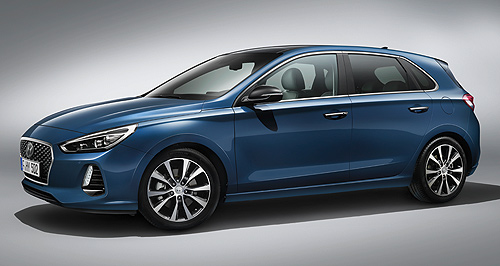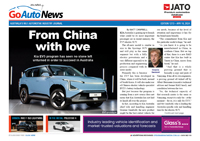Make / Model Search
Future models - Hyundai - i30Hyundai’s new-model blitzWho new: Hyundai’s all-new i30 hatchback will kick off a new-model blitz that will take the Korean company into the luxury, high-performance and green vehicle segments in Australia. Eleven new models set to reshape Hyundai in Australia in 18 monthsGallery Click to see larger images 29 Sep 2016 By RON HAMMERTON in PARIS HYUNDAI Motor Company Australia (HMCA) is laying the groundwork for the biggest round of new-model launches in its history, with at least 11 all-new or facelifted models coming down the pipeline in the next two years. The fresh metal ranges from the mass-selling third-generation i30 small hatchback that is making its debut this week at the Paris motor show, to the plug-in electric Ioniq due in the third quarter of next year and a hydrogen fuel-cell car in 2018. The first of its high-performance N division models, the i30-based i30N, and an all-new rear-wheel-drive luxury BMW 3 Series rival, the Genesis G70, are also waiting in the wings for a 2017 splash. The G70 will join a facelifted version of the current Genesis large car that next year will be re-badged as the Genesis G80 to form part of the initial two-model Genesis range to take on the likes of Lexus and Infiniti, as well as the Euro brands, through a 30-dealer national specialist network. A large SUV based on the G80 will join the Genesis range in Australia in 2018 after being recently confirmed for right-hand drive (see separate story). Hyundai’s SUV stocks will be boosted by the arrival of the company’s first sub-Tucson small SUV in the second half of 2017 when it will go up against hot-selling baby wagons such as the Mazda CX-3, Mitsubishi ASX, Honda HR-V and Toyota’s upcoming C-HR. At the top of the Hyundai SUV range, the next Santa Fe large SUV is due in Australia in 2018, to be followed by a hydrogen fuel-cell car that has already achieved an order for 20 vehicles from the Australian Capital Territory government which plans to generate the hydrogen to run them from wind power. A new Veloster sports coupe is also in the offing in 2018, rounding out a hectic launch program that Hyundai hopes will take it to the next level in the Australian motor industry. Volume wise, the two most important models are the new i30 – arriving in five-door hatch form in Australian in the second quarter of 2017 – and the unnamed compact SUV due a few months later. Speaking in Paris ahead of the i30 reveal, HMCA public relations general manager Bill Thomas said the new i30 would still be about value, but would move up a level in terms of engineering, quality and specification. He said this would mean that the new generation of Hyundai’s top-selling car could not be expected to be a low-price leader, instead appealing to buyers who wanted more out of their small car. So far this year, the i30 is the second biggest selling small car in the land, with 26,937 sales to the end of August, trailing Toyota’s Corolla by little more than 1000 units. However, if the 3360 sales of Hyundai’s sedan version, the Elantra, are taken into account, Hyundai’s small-car line-up is a clear winner. In Australia, the i30 will come initially only in a five-door hatchback configuration, with the three-door and wagon variants dropped. However, the company has given solid hints that a five-door liftback “coupe” will be forthcoming at some point. This could be expected to come to Australia where its stylish shape would add gloss to the i30’s image. Although pricing and specification for the new i30 hatch are yet to be confirmed, we expect the current base engine, the 107kW 1.8-litre petrol four-cylinder, to be dropped. Instead, the 2.0-litre normally aspirated GDI petrol engine that puts out about 124kW of power in the current mid-range i30 SR will become the new entry-level powerplant. It will be mated with a six-speed torque converter automatic transmission. Moving up the scale, the mid-range i30 will get Hyundai’s 150kW turbo petrol engine from the Veloster, mated with a choice of seven-speed dual-clutch transmission or six-speed manual gearbox. While some manufacturers are re-thinking their diesel strategy in small cars, Hyundai will continue with the 100kW 1.6-litre CRDi diesel for buyers wanting diesel efficiency and torque. The diesel i30 and the petrol variants are expected to ride on a simple torsion-beam rear suspension, while the 1.6 turbo will get a more sophisticated multi-link setup. Rounding out the 2017 i30 range will be Hyundai’s first genuine hot hatch, the i30N, that arrives in the third quarter. Armed with 2.0-litre four-cylinder petrol engine turning out about 192kW of power, the five-door, front-wheel drive i30N is a product of a joint effort between Hyundai’s development teams in Europe and Korea. It has been pounded around the Nurburgring where it has been benchmarked against European and Japanese cars such as the Volkswagen Golf GTI, Renault Megane RS and Honda Civic Type R. An even hotter version to take up cudgels against Mercedes-AMG’s A45, Audi’s RS3 and Ford’s Focus RS has also been mooted. Not content with charging into the high-performance hatchback and luxury segments in 2017, Hyundai is also going after the green vote with its Toyota Prius rival, the Ioniq. On sale in other markets this year, HMCA has had to cool its heels while waiting to get into the production queue for Ioniq that comes in three variants – hybrid, plug-in hybrid and all-electric. Although HMCA has hinted it will start with the plug-in hybrid because it should be the most logical of the three for this market, it says it has not ruled out the others at this stage.
 Read more8th of September 2016  Paris show: Hyundai unlocks new i30New tech, premium interior and evolutionary design for Hyundai’s new-gen i301st of September 2016  Genesis chalks 30 dealerships for AusThirty Hyundai showrooms to form Genesis’ Australian dealer network from March 2017All future models Alfa Romeo Alfa Romeo Abarth Abarth Alpine Alpine Alpina Alpina Audi Audi Aston Martin Aston Martin BMW BMW Bentley Bentley Chery Chery Brabham Brabham Chrysler Chrysler Chevrolet Chevrolet Cupra Cupra Citroen Citroen DS DS Dodge Dodge Fiat Fiat Ferrari Ferrari Foton Foton Ford Ford Great Wall Great Wall FPV FPV Haval Haval GWM GWM Honda Honda Holden Holden Hummer Hummer HSV HSV Infiniti Infiniti Hyundai Hyundai Jaguar Jaguar Isuzu Isuzu Kia Kia Jeep Jeep Land Rover Land Rover Lamborghini Lamborghini Lexus Lexus LDV LDV Mahindra Mahindra Lotus Lotus Mazda Mazda Maserati Maserati Mercedes-AMG Mercedes-AMG McLaren McLaren MG MG Mercedes-Benz Mercedes-Benz Mitsubishi Mitsubishi Mini Mini Opel Opel Nissan Nissan Peugeot Peugeot Pagani Pagani Proton Proton Porsche Porsche Renault Renault Ram Ram Rover Rover Rolls-Royce Rolls-Royce Skoda Skoda Saab Saab SsangYong SsangYong Smart Smart Suzuki Suzuki Subaru Subaru Toyota Toyota Tesla Tesla Volvo Volvoi30 pricing
Motor industry news |
Click to shareHyundai modelsAll future models Alfa Romeo Alfa Romeo Abarth Abarth Alpine Alpine Alpina Alpina Audi Audi Aston Martin Aston Martin BMW BMW Bentley Bentley Chery Chery Brabham Brabham Chrysler Chrysler Chevrolet Chevrolet Cupra Cupra Citroen Citroen DS DS Dodge Dodge Fiat Fiat Ferrari Ferrari Foton Foton Ford Ford Great Wall Great Wall FPV FPV Haval Haval GWM GWM Honda Honda Holden Holden Hummer Hummer HSV HSV Infiniti Infiniti Hyundai Hyundai Jaguar Jaguar Isuzu Isuzu Kia Kia Jeep Jeep Land Rover Land Rover Lamborghini Lamborghini Lexus Lexus LDV LDV Mahindra Mahindra Lotus Lotus Mazda Mazda Maserati Maserati Mercedes-AMG Mercedes-AMG McLaren McLaren MG MG Mercedes-Benz Mercedes-Benz Mitsubishi Mitsubishi Mini Mini Opel Opel Nissan Nissan Peugeot Peugeot Pagani Pagani Proton Proton Porsche Porsche Renault Renault Ram Ram Rover Rover Rolls-Royce Rolls-Royce Skoda Skoda Saab Saab SsangYong SsangYong Smart Smart Suzuki Suzuki Subaru Subaru Toyota Toyota Tesla Tesla Volvo Volvoi30 pricing
Motor industry news |
||||||||||||||||||||||||||




















Facebook Twitter Instagram